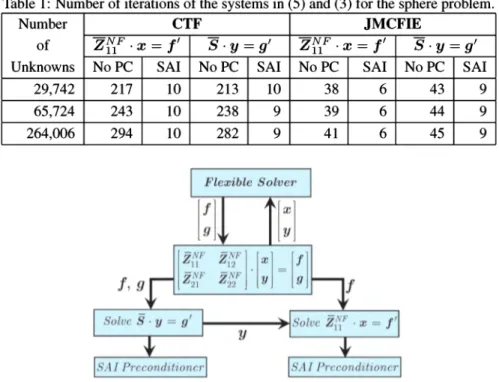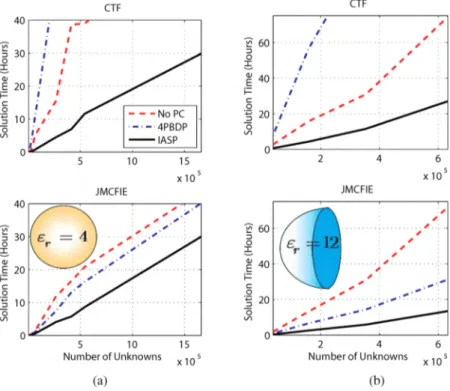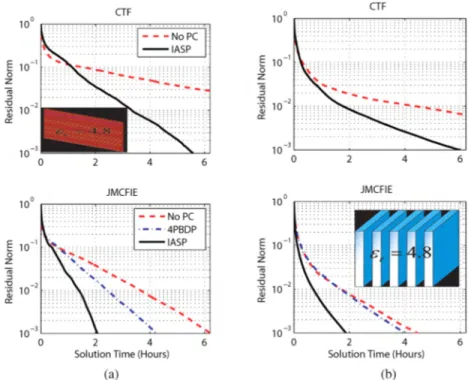An Effective Preconditioner Based on Schur Complement Reduction for Integral-Equation Formulations of Dielectric Problemst
Tahir MalasI ,2and Levent GiireII ,2*
IDepartment of Electrical and Electronics Engineering 2Computational Electromagnetics Research Center (BiLCEM)
Bilkent University, TR-06800, Bilkent, Ankara, Turkey E-mail: {tmalas.lgurel}@ee.bilkent.edu.tr
Introduction
We consider effective preconditioning of recently proposed two integral-equation formulations for dielectrics; the combined tangential formulation (CTF) and the electric and magnetic current combined-field integral equation (JMCFIE) [1]. These two formulations are of utmost interest since CTF yields more accurate results and JMCFIE yields better-conditioned systems than other formu-lations [2].
Integral-equation formulations for dielectrics are obtained by simultaneous discretization of the elec-tric and magnetic surface currents and result in block-partitioned linear systems in the form of
(1) whereaJandaMare the coefficient vectors of the basis functions expanding the electric and
mag-netic currents, respectively, andv1,2 represent excitation vectors obtained by testing the incident
fields. The iterative solutions of the resulting dense systems become feasible with the multilevel fast multipole algorithm (MLFMA). However, the solutions of such block-partitioned matrices often suffer from slow convergence, due to highly indefinite nature of resulting matrices. Hence, effective preconditioners should be applied to these systems in order to increase robustness and efficiency.
Iterative Approximate Schur Preconditioner
We use the near-field matrix for preconditioning, i.e., 1VI
=
ZNF. For the solution of theprecon-ditioning system, the Schur complement reduction method is used [3]. This method reduces the solution of the block-partitioned near-field system
to the solution of the following two systems. First,y is found using
-S·y=g-Z2I .-NF (-NF)-IZII .!=g,I
where
- -NF -NF (-NF)-I -NF
S=Z22 -Z2I . ZII ·ZI2 is the Schur complement matrix. Then,x can be computed by solving
(2)
(3)
(4)
(5) Since the inversion of the sparse matrix ZjiF is unfeasible, in the right-hand side of (3) and Schur
complement matrix (4), we approximate the inverse ofZjiF with a sparse approximate inverse
tThis work was supported by the Scientific and Technical Research Council of Turkey (TUBITAK) under Research Grants l05E172 and l07E136, by the Turkish Academy of Sciences in the framework of the Young Scientist Award Program (LG/TUBA-GEBIP/2002-1-12), and by contracts from ASELSAN and SSM.
(SAl) [4]. Then, solutions of (3) and (5) are approximated by a few iterations of the generalized minimal residual method (GMRES). We call these preconditioning solutions inner solutions and the preconditioning scheme the iterative approximate Schur preconditioner (ASP). Note that we do not need to compute and store the Schur complement matrixS;we only need to provide the application ofSto a vector in each step of the inner iterative solver of (3).
We increase the performance of iterative ASP by accelerating the inner solves (3) and (5) with SAl of Z~Fand ZjiF, respectively. Note that for CTF and JMCFIE, ZjiF
=
Z~F, hence SAl of ZjiF serves as a preconditioner for (3), assuming that Z~F is the dominant term in the Schur complement matrix. Therefore, SAl is used both in approximating the inverse of ofZjiF and to accelerate the iterative solutions of (3) and (5). In Table 1, we show the performance of the SAl preconditioner for the solutions of (3) and (5), where we compare the number of iterations obtained with the SAI-preconditioner and the no-preconditioner (No PC) cases for 10-6 residualerror. For both formulations, we observe that SAl is very successful and decreases the iteration counts drastically. Furthermore, contrary to the the no-preconditioner case, the number of iterations does not increase for the SAl preconditioner as the number of unknowns increase. In Fig. 1, we illustrate the application of iterative ASP in a step of a Krylov subspace solver. Note that, if the number of iterations of the inner solver is not fixed, the use of iterative ASP requires the outer solver to be a flexible solver [3].
Table 1: Number of iterations of the systems in (5) and (3) for the sphere problem.
Number CTF JMCFIE
of ZjiF. x
= /'
S·y=g' ZjiF. x= /'
S·y=g'Unknowns No PC SAl No PC SAl No PC SAl No PC SAl
29,742 217 10 213 10 38 6 43 9
65,724 243 10 238 9 39 6 44 9
264,006 294 10 282 9 41 6 45 9
[~l
I:]
Figure 1: Illustration of the application of ASP in a step of an iterative solver.
Results
In Fig. 2, we show the total solution times (setup of SAl and iterations) obtained with the no-restart flexible GMRES for a sphere problem with a dielectric constant of 4.0 and for a real-life problem of a dielectric lens [5], which has a higher relative permittivity of 12.0. We solve problems up to 1.5 million unknowns for the sphere and up to 600,000 unknowns for the lens. Iterative ASP is compared to No PC and a four-partition block-diagonal preconditioner (4PBDP) [2], which uses the self interactions of the lowest-level clusters of MLFMA. However, this preconditioner worsens the convergence behaviour of CTF. We use 0.1 residual error and a maximum of three iterations
for the inner solutions. First, we note that these problems are much harder to solve with other non-optimal solvers, such as biconjugate gradient stabilized (BiCGStab) [2]. GMRES, on the other hand, is able to solve these problems without a preconditioner, though it may require many iterations. Using iterative ASP, both iteration counts and solution times of CTF and JMCFIE are significantly improved. Moreover, for the sphere problem, iteration counts and solution times of CTF are very close to those of JMCFIE. Hence, CTF is preferable to JMCFIE when iterative ASP is used as the preconditioner since it produces more accurate results than JMCFIE [2].
4 JMCFIE 2 CIF O-=::;;;....---L---'---'--'
:,,:
~ 60 ... , ....g
,
~,
E
40 . . , .. ~,
§ ,-g
20 ., .. e V') 10 JMCFIE 5 CIF 40 I I -I I ~ 30 . '1" . I. e I ~ I IE
20 ..! ...~ . ~ I I §i,'
-5 10 '1"", eV') I'_I o~__..i...-_----':::::::;::::====::::::;:::::::.J 2 4 6 Number of Unknowns x105 :, ,: ...,
;'..:..,
,
.,
. ..:;.; ..,.
,
,..' ~....
;.;.;.;;;.;,..
,~...
,
. -'::',' -:'--Ol:ill!i!~=:::;:=---...i....----i...J ~ 60 .. ~ o ~E
40 .. ~ c o-g
20 . e V') 5 10 15 Number of Unknowns x105 ~ 30 e ~ (a) (b)Figure 2: Number of iterations and the solution times for (a) the sphere problem and (b) the lens problem with CTF and JMCFIE. The stopping criterion is set at 10-3residual error.
In Fig. 3, we provide solution time versus norm of the residual plots for two real-life photonic crystal problems; one is a layered dielectric medium [6] and the other one is a slab material with inner holes [7]. These problems have relative dielectric constants of 4.8 and 11.56, respectively. The layered medium is solved at 300 MHz, has five layers with four meter walls, and involves 131,460 unknowns. The slab material is solved at 8.25 GHz, has15 x 20 inner holes, and involves 162,420 unknowns. These problems cannot be solved with JMCFIE using 4PBDP in 2,000 iterations. Also, with CTF formulation, GMRES cannot solve the problems without a preconditioner. On the other hand, using iterative ASP we have been able to solve these problems in approximately six hours with CTF and in two hours with JMCFIE.
Conclusion
Integral-equation formulations for dielectrics have a wide range of application areas. However, iterative solutions of the resulting dense systems with MLFMA often suffers from slow convergence. We propose the iterative ASP preconditioner based on the Schur complement reduction technique to solve the near-field matrix system efficiently. The only cost of the preconditioner is the construction of a SAl for the (1,1) partition. Using this effective preconditioner, we obtain the CTF solutions of the sphere problems as fast as the JMCFIE solutions. For other real-life problems, both CTF and JMCFIE solutions can be obtained with ASP in modest times.
6 4 2 10°
~~:::::~I"""':::::::::::::::"""~"""I:
:::: : - - - No PC : :::: : --IASP : . . (ij ~ ~ 10-2 a:: aF 6 JMCFIE 2 4Solution Time (Hours) 6
2 4
Solution Time (Hours)
JMCFIE 10° :::::::::::::::::::::::: .
i::::
!!"'~,~,~!;~w:,:~t:,:::::::::
::::::::::: ::::::::::~,~:::::::::~: ~:::: ... : ~.:,
:. 10-3 '---''.a....c...- ' : o (a) (b)Figure 3: Number of iterations and the solution times for (a) the photonic crystal and (b) dielectric layers with CTF and JMCFIE.
References
[1] P. YHi-Oijala, M. Taskinen, and S. Jarvenpaa, "Surface integral equation formulations for solv-ing electromagnetic scattersolv-ing problems with iterative methods," Radio Science, 2005.
[2]
O.
Ergiil and L. Giirel, "Comparison of integral-equation formulations for the fast and accu-rate solution of scattering problems involving dielectric objects with multilevel fast multipole algorithm," IEEE Trans. Antennas Propagat., accepted for publication, Sept. 2008.[3] M. Benzi, G. H. Golub, and J. Liesen, "Numerical solution of saddle point problems," Acta
Numer.,vol. 14, pp. 1-137,2005.
[4] T. Malas and L. Giirel, "Accelerating the multilevel fast multipole algorithm with the sparse-approximate-inverse (SAl) preconditioning," SIAM J. Sci. Comput., accepted for publication, Dec. 2008.
[5] A. P. Pavacic, D. Llorens del Rio, J. R. Mosig, and G. V. Eleftheriades, "Three-dimensional ray-tracing to model internal reflections in off-axis lens antennas," IEEE Trans. Antennas Propagat., vol. 54,pp. 604-612,2006.
[6] P. Loschialpo, D. W. Forester, and J. Schelleng, "Anomalous transmission through near unit index contrast dielectric photonic crystals," Journal of Applied Physics, vol. 86, no. 10, pp. 5342-5347,1999.
[7] D. Pissoort, E. Michielssen, D. V. Ginste, and F. Olyslager, "Fast-multipole analysis of elec-tromagnetic scattering by photonic crystal slabs," J. Lightwave Technol., vol. 25, no. 9, pp. 2847-2863,2007.


